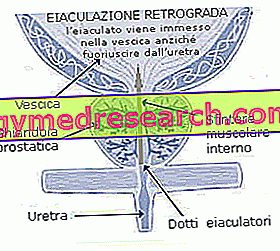Definition of retrograde ejaculation
Popularly little known, retrograde ejaculation is a disorder in which the ejaculate is introduced into the bladder instead of escaping from the penile urethra; ejaculation is defined as "retrograde" precisely because the emission of sperm occurs on the contrary, not towards the outside but towards the bladder. The "normal" ejaculation, on the other hand, is instead defined as anterograde, precisely because the seminal fluid is expelled to the outside.
Contrary to what one might think, retrograde ejaculation is not painful: the sperm, which remains trapped inside the bladder, is expelled along with the urine during urination immediately following coition.

Causes
In all likelihood, retrograde ejaculation is due to the impossibility for the bladder to close during the ejaculatory act, as in normal conditions; consequently, retrograde sperm flow cannot be prevented.
Failure to close the entrance to the bladder is caused, in turn, by physical trauma at the bladder level or by neurological, congenital or acquired deficits.
Retrograde ejaculation is a problem that affects many diabetics: diabetic neuropathy appears to be the main cause of damage to the nervous connection to the bladder.
Among the other causative factors directly implicated in retrograde ejaculation, prostate dysfunctions, autonomic nervous system deficiencies, surgical complications involving prostate and bladder neck, and TURP (acronym for trans urethral endoscopic prostatic resection, the most famous intervention aimed at treatment of prostatic hypertrophy).
Retrograde ejaculation was also diagnosed after targeted surgical procedures, such as endoscopic electrosurgery of benign prostatic adenomas, prostatic adenomyectomy, spinal surgery and pelvic organs, retro peritoneum surgery.
Retrograde ejaculation and drugs
It has been shown that the inordinate use of some classes of drugs can enhance the damage at the ejaculatory level, generating a spermatic retrograde emission during orgasm: in particular, the neuroleptic and antihypertensive drugs increase the probability of generating this disorder. Searching even more minutely, a clear correlation between the administration of thioridazine and risperidone (antipsychotics) and retrograde ejaculation is evident: these drugs exert antiserotoninergic and antiadrenergic effects, causing a defect in the ejection of the ejaculate, which is emitted inside of the bladder. In any case, the interruption of the pharmacological treatment allows the reversibility of the retrograde ejaculatory condition, that is to say a clear improvement of the symptomatological picture and a return to normality. [taken from guidelines for the treatment of schizophrenia, by E. Sacchetti].
Retrograde ejaculation could also occur in patients undergoing pharmacological treatments with alpha-blockers, useful for the treatment of cervico-urethral obstruction; also in this case, the condition is reversible at the end of the therapy.
Dry orgasm
Erroneously, many patients suffering from retrograde ejaculation speak of dry orgasm: it is necessary to clarify, since the two conditions are not synonymous.
- Dry orgasm: produces orgasmic sensations comparable to physiological ones, but sperm emission during ejaculation is denied. Probably, the dry - or dry - orgasm is due to the lack of prostatic, testicular and deferent peristalsis. The sensations generated by the dry orgasm, in humans, are the consequence of repeated contractions of the ischio / bulb / cavernous muscles. In medical terms, the dry orgasm is called anejaculation.
- Retrograde ejaculation: unlike the dry orgasm, sperm emission is present but the ejaculate goes towards the bladder, resulting in a subsequent spill, together with the urine. Some patients with retrograde ejaculation also complain of psychological anorgasmia, caused by the lack of immediate sperm vision.
Diagnosis
The examination of urine is essential in case of retrograde ejaculation, since, as already discussed, the ejaculate is emitted together with the urine, subsequently to coitus. Through urinalysis and urodynamics it is possible to verify the presence of elements of the germ line in the urine, thus diagnosing retrograde ejaculation.
However, in a patient suffering from azoospermia, the absence of spermatozoa in the urine does not rule out retrograde ejaculation with certainty: in similar situations, the search for fructose in urine is recommended. [taken from medical sexology. Treatise on psychosexology and medicine of sexuality. By Emmanuele A. Jannini, Andrea Lenzi, Mario A. Maggi].
Among other diagnostic strategies, trans-rectal prostatic ultrasound may also be a valid aid for the investigation of any morphological-structural anomalies of the seminal vesicles.
Care
Retrograde ejaculation should not be underestimated because it could be an obvious cause of sterility; in this regard, it is a must to contact the specialist as soon as you notice the problem.
The treatment of choice is medical-pharmacological therapy: imipramine (an antidepressant drug) and pseudo-ephedrine have proved to be remarkably advantageous in resolving retrograde ejaculation: it is estimated that, following this drug therapy, the prognosis is excellent in 40% of cases.
However, the pharmacological substances used do not prove useful in all patients: another technique used is electro-ejaculation, in which the emission of sperm is favored by the introduction of a probe in the rectum, capable of stimulating the seminal vesicles.
When the treatments just described prove ineffective, and men suffering from retrograde ejaculation want a child, they must make use of assisted fertilization: the seminal fluid is collected from a urine sample (after coitus), then subsequently used for assisted fertilization, with excellent results.
Summary
Retrograde ejaculation: in short
| Retrograde ejaculation | Phenomenon by which the ejaculate is introduced into the bladder instead of escaping from the penile urethra; ejaculation is defined as "retrograde" precisely because the sperm emission occurs in reverse |
| Causes of retrogada ejaculation | Retrograde ejaculation is due to the inability of the mouth to close during the ejaculatory act, caused mainly by:
|
| Retrograde ejaculation and administration of drugs | Retrograde ejaculation can also be favored by the administration of some drugs:
|
| Retrograde ejaculation and dry orgasm | Dry orgasm : produces orgasmic sensations comparable to physiological ones, but sperm emission during ejaculation is denied Retrograde ejaculation : sperm emission is present but the ejaculate goes to the bladder, resulting in subsequent leakage, along with the urine |
| Retrograde ejaculation: diagnosis | Urinalysis and urodynamics: they allow to verify the presence of elements of the germ line in the urine Trans-rectal prostatic ultrasound: allows the investigation of any morphological-structural anomalies of the seminal vesicles |
| Retrograde ejaculation: therapies |
|



